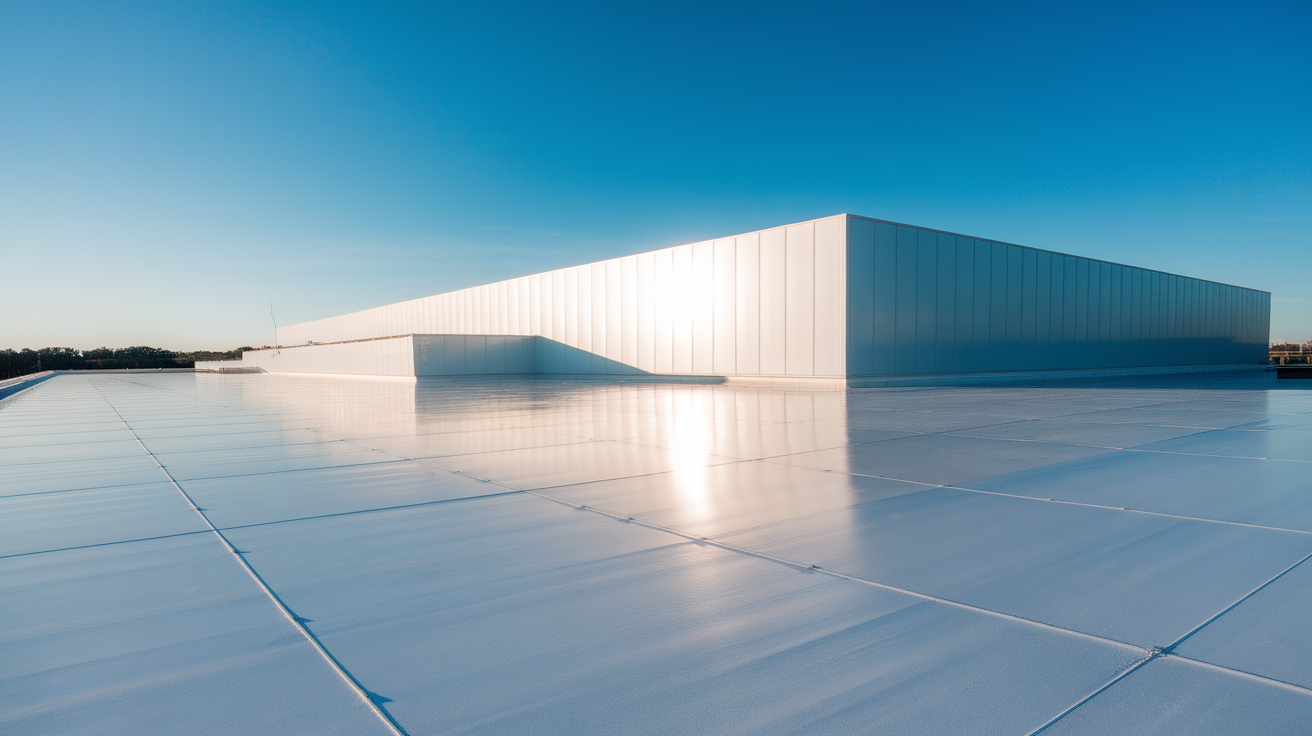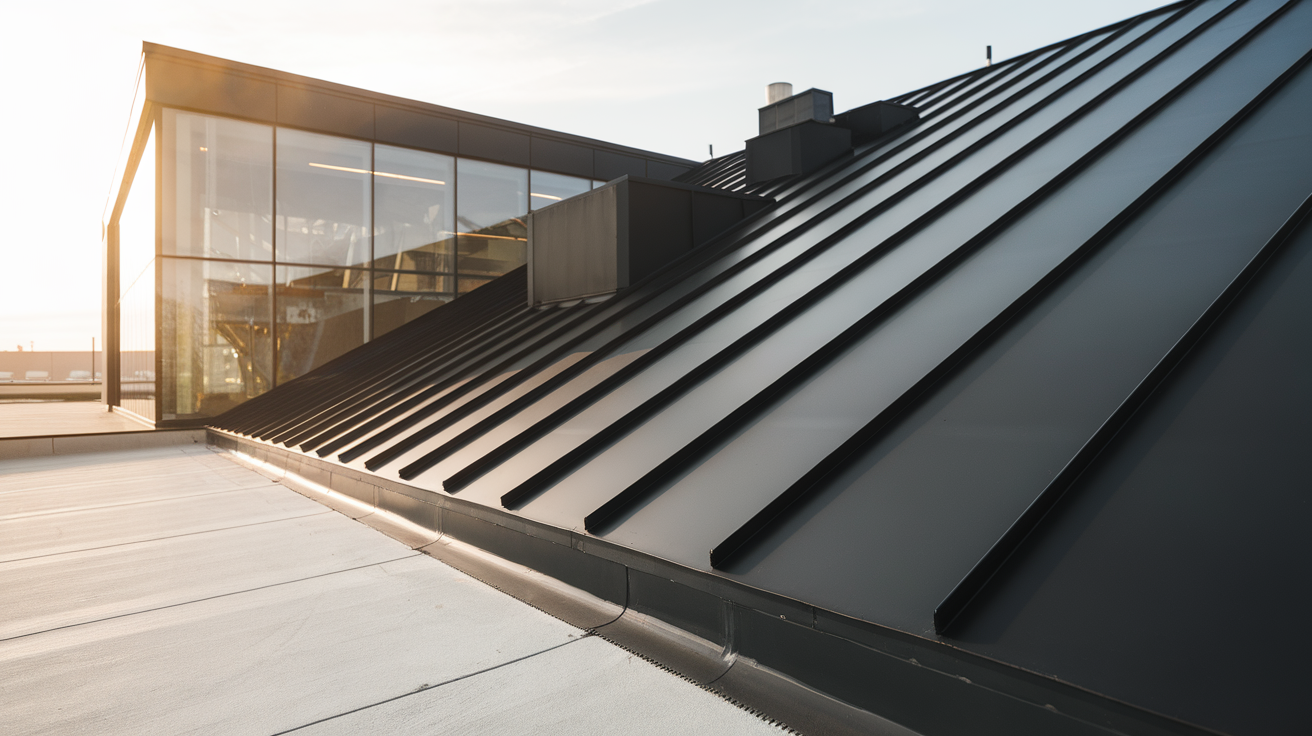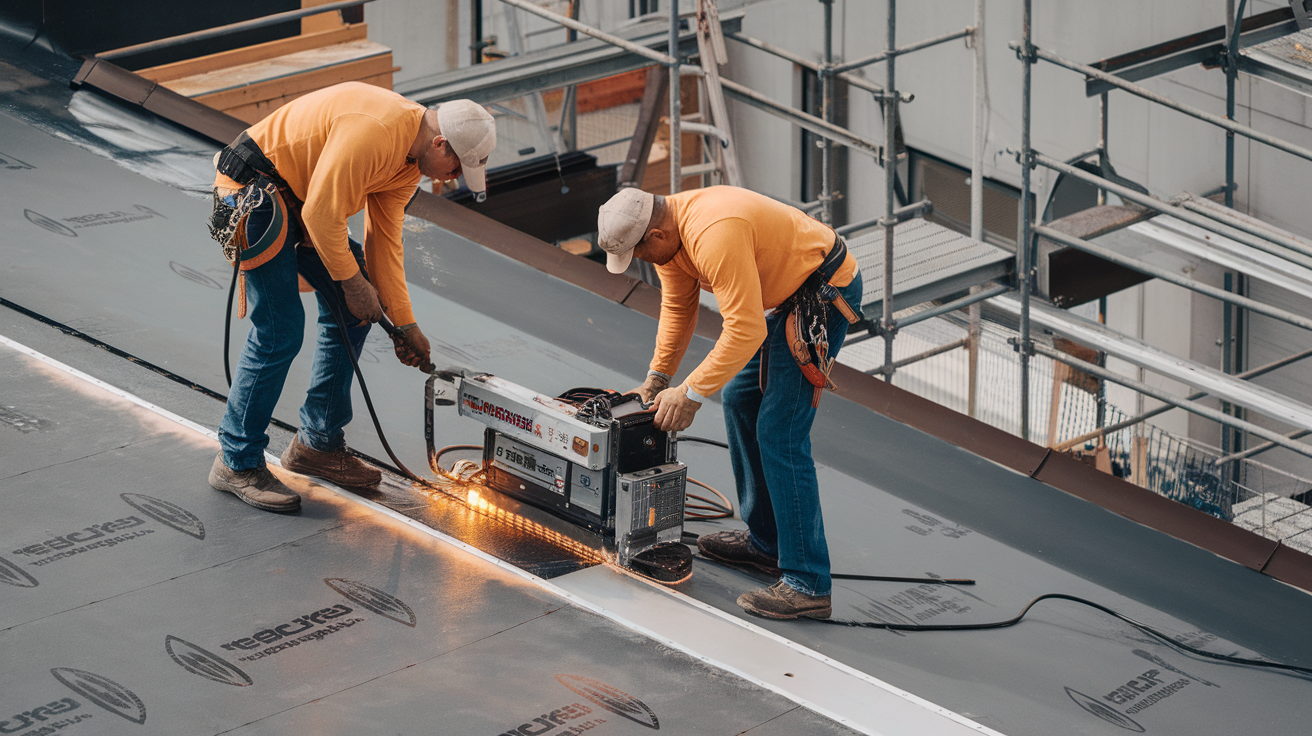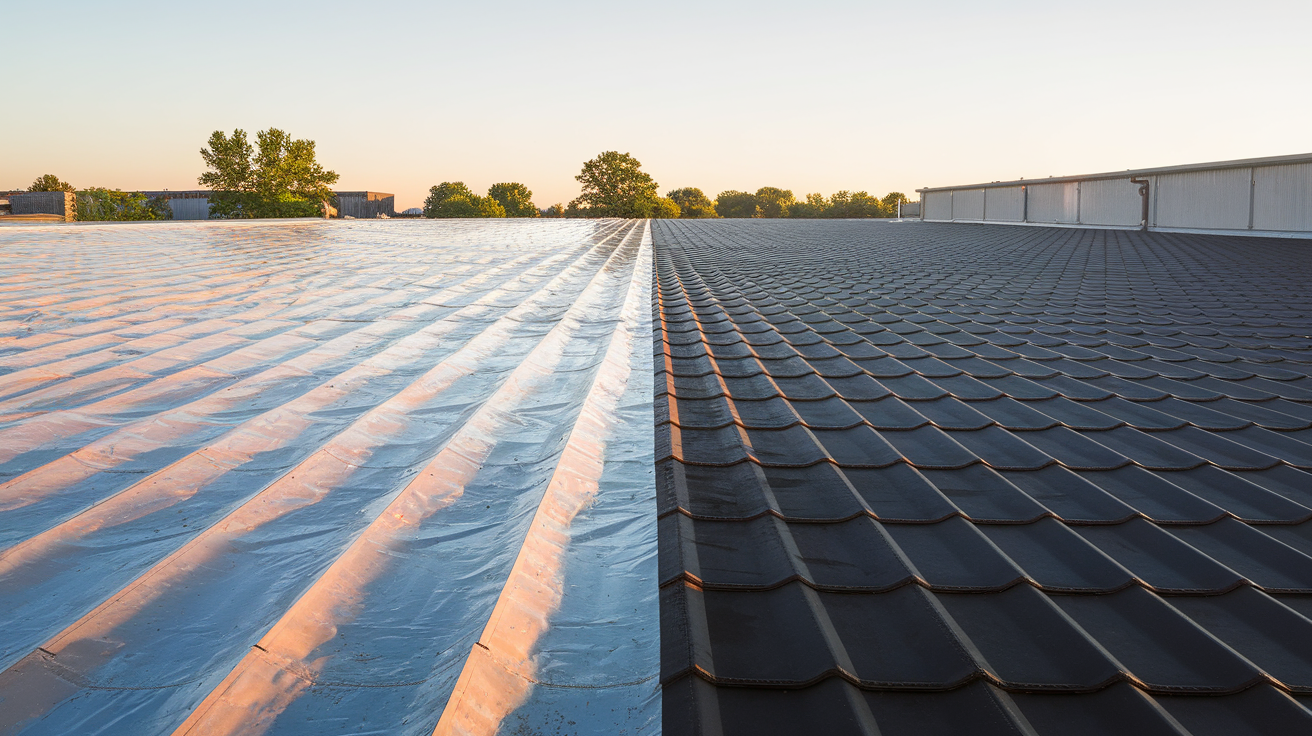When choosing a roofing system for your commercial building, TPO (Thermoplastic Polyolefin) and EPDM (Ethylene Propylene Diene Monomer) are two popular options.
Both are single-ply membranes, but they differ in materials, installation methods, and performance.
TPO is known for its energy efficiency and reflective properties, making it ideal for warmer climates.
EPDM, on the other hand, is highly durable and flexible, offering excellent resistance to extreme temperatures and UV rays.
In this article, I’ll break down the key differences, advantages, and disadvantages of TPO and EPDM roofing so that you can make the best choice for your property.
What Is TPO Roofing?

TPO is a single-ply roofing membrane known for its durability, energy efficiency, and cost-effectiveness.
It’s made from a blend of polypropylene and ethylene-propylene rubber, giving it the flexibility and strength needed for commercial roofs.
TPO roofing is typically installed using heat-welding, which fuses the seams of the membrane together to create a watertight seal.
The reflective surface of TPO helps reduce cooling costs, making it an energy-efficient option for buildings in hot climates.
TPO roofs are also known for their UV resistance, which helps them maintain their appearance and performance over time.
The material is highly flexible, which allows it to withstand the movement and expansion of a building. It’s also resistant to punctures and tears, adding to its durability.
What Is EPDM Roofing?

EPDM, on the other hand, is a rubber roofing material made primarily from ethylene, propylene, and a diene monomer.
It’s known for its longevity and is one of the most commonly used roofing materials in commercial buildings.
EPDM roofing has been around for decades and is widely regarded as one of the most durable options available.
EPDM can be installed using three primary methods: ballasted, mechanically attached, or fully adhered.
The material is flexible and can withstand a wide range of temperatures, making it a great option for buildings in both hot and cold climates.
EPDM roofing is also UV resistant and can last for up to 50 years with proper care.
TPO vs. EPDM: A Side-by-Side Comparison
| Feature | TPO Roofing | EPDM Roofing |
|---|---|---|
| Lifespan | 20–30 years | 30–50 years |
| Durability | Good, but may degrade over time. | Excellent, resistant to ozone and UV degradation. |
| Energy Efficiency | Highly reflective, reduces cooling costs. | The black version absorbs heat; the white version is available. |
| Cost | Generally more affordable. | Slightly more expensive, but a longer lifespan may offset the cost. |
| Installation | Requires skilled labor for heat-welding. | Easier installation with various methods. |
| Maintenance | May require more frequent inspections. | Low maintenance; long-term performance. |
Climate Considerations: Which Roofing System Works Best?
When choosing between TPO and EPDM, it’s important to consider the climate of your building’s location.
TPO
Ideal for warmer climates, TPO has a highly reflective surface that bounces off heat from the sun.
This helps keep your building cooler and reduces the need for air conditioning.
If your building experiences hot summers, TPO can help save on cooling costs and extend the lifespan of your HVAC system.
EPDM
Highly versatile in temperature extremes, EPDM is a great option for colder climates.
The black version of EPDM absorbs heat, keeping your building warmer in the winter and reducing heating costs.
It also performs well in freezing temperatures and heavy snow, making it a solid choice for colder regions.
Installation and Maintenance: What You Need to Know

Both TPO and EPDM offer different installation methods, which can impact both the upfront cost and long-term maintenance.
TPO Installation: TPO roofing is typically installed using heat-welding. This process requires specialized equipment and skilled labor to ensure that the seams are sealed tightly.
This is a major advantage because heat-welded seams are strong, watertight, and resistant to leaks.
However, the installation process can be more expensive and time-consuming compared to EPDM, especially if the roof is large or complicated.
EPDM Installation: EPDM offers more flexibility in terms of installation methods. It can be installed using ballasted, mechanically attached, or fully adhered methods, depending on your needs.
The ballasted method uses stones or gravel to hold the membrane in place, while the mechanically attached method involves fastening the membrane to the roof deck.
The fully adhered method uses adhesive to bond the EPDM to the roof surface. Because of these options, EPDM installation tends to be less labor-intensive than TPO, potentially lowering the initial cost.
Maintenance: When it comes to maintenance, TPO requires more frequent inspections, especially around the seams and areas where the membrane is exposed to the sun.
Over time, the reflective surface of TPO can degrade, and the roof may become more susceptible to punctures or tears.
This means you might need to repair or replace sections of the roof sooner than you would with EPDM.
EPDM, on the other hand, is known for its low maintenance needs. Its rubber composition makes it resistant to UV rays, ozone, and extreme temperatures.
As long as you keep an eye on the seams and make sure that any punctures or tears are repaired quickly, your EPDM roof can last for decades with minimal attention.
Advantages and Disadvantages of TPO and EPDM Roofing
When choosing between TPO (Thermoplastic Polyolefin) and EPDM (Ethylene Propylene Diene Monomer) roofing systems, it’s important to weigh their advantages and disadvantages to determine which best suits your needs.
Advantages of TPO Roofing:
- Energy Efficiency: Reflective surface helps reduce cooling costs, ideal for hot climates.
- Cost-Effectiveness: More affordable upfront and quicker installation.
- UV Resistance: Resists UV rays, maintaining appearance and performance.
- Flexibility: Expands and contracts with building movement, and is puncture-resistant.
Disadvantages of TPO Roofing:
- Shorter Lifespan: Typically lasts 20-30 years; reflective surface degrades over time.
- Frequent Maintenance: Requires more inspections and repairs due to wear.
- Vulnerability to Chemical Damage: Not resistant to some chemicals or oils.
Advantages of EPDM Roofing:
- Longevity: Lasts 30-50 years, a great long-term investment.
- Durability: Resistant to UV, ozone, and extreme weather, great for both hot and cold climates.
- Low Maintenance: Minimal upkeep needed after installation.
- Flexibility in Installation: Multiple installation options reduce cost and time.
Disadvantages of EPDM Roofing:
- Higher Initial Cost: More expensive upfront compared to TPO.
- Energy Efficiency: Black surface absorbs heat, making it less energy-efficient in warmer climates.
- Aesthetic Appeal: Dark rubberized surface may not suit all building designs.
Cost Analysis: Which One Fits Your Budget?
Here’s a breakdown of the cost comparison between TPO and EPDM:
TPO:
- Typically more affordable, especially for smaller roofs.
- The material is less expensive, and installation costs are lower due to easy heat-welding installation.
- However, TPO may require more frequent maintenance, which can add to the overall cost.
EPDM:
- Higher upfront cost, but offers greater durability and a longer lifespan.
- The initial investment is higher, but lower maintenance costs and extended lifespan may make it more cost-effective in the long run.
- A better option for those planning to stay in the building for many years, as it provides long-term value.
Both materials have their pros and cons, so consider your building’s needs and long-term plans when making your decision.
Durability: Which Roof Will Last Longer?
When it comes to durability, EPDM takes the lead.
While TPO can last 20-30 years, EPDM roofs are known to last between 30 and 50 years with proper care.
EPDM is highly resistant to the elements, including UV rays, ozone, and harsh weather conditions.
Its rubber composition makes it highly flexible, allowing it to expand and contract without cracking, which is especially important in areas with extreme temperature changes.
TPO, while durable, can degrade over time, especially in areas with high UV exposure.
The reflective coating that makes TPO energy-efficient can also wear down, leaving the roof more susceptible to damage.
If you want a roofing material that will stand the test of time and offer exceptional longevity, EPDM is the better option.
Which Roofing System Is Right for Your Building?
So, how do you decide between TPO and EPDM? It all comes down to your specific needs and the location of your building. Here are a few considerations:
- TPO is ideal for warm climates. If you live in an area with hot summers, TPO’s reflective properties will help reduce cooling costs.
- EPDM is a better choice for colder climates. If you’re in a region that experiences freezing temperatures and snow, EPDM’s heat-retaining properties will help keep your building warmer during the winter.
- Consider the long-term costs. If you’re planning on staying in the building for many years, EPDM’s long lifespan and low maintenance needs may make it a better investment.
- Think about installation and budget. If you’re working with a tight budget and need a quick installation, TPO may be the better choice for you. However, if you’re looking for a long-term solution that requires less maintenance, EPDM is worth the extra upfront cost.
Conclusion
Choosing the right roofing system for your commercial building is a significant decision.
Both TPO and EPDM have their advantages, and the right choice depends on your specific needs.
TPO is great for buildings in warmer climates and offers a cost-effective solution with energy-efficient benefits. However, EPDM shines when it comes to durability, longevity, and versatility, making it a smart long-term investment.
I recommend consulting with a roofing professional to assess your building’s needs and help you make the best choice for your property.
Don’t hesitate to reach out for advice and guidance; your roof plays a crucial role in protecting your building for years to come.

